Liatris spikelet: description of varieties, planting and care

Spikelet liatris is a beautiful plant that is not found in Russian latitudes, but is actively used in cultural gardening. Its delicate lilac inflorescences adorn flower beds, mixborders. Liatris "Alba" and Kobold, Floristan Violett and "Blue" are popular with summer residents and landscape design professionals. We will give a description of the various varieties, give advice on planting and caring for a plant in the open field.


Description
Spikelet liatris is a perennial plant and is cultivated all over the world even in temperate climates. This is a herbaceous crop that has a corm instead of a regular root. Spikelet liatris, as this species is also called, belongs to the genus Liatris, famous for its unusual flowers in shape and shade. In nature, this plant is found in eastern Canada, Mexico, the Bahamas and other southern states of the United States.


Liatris spiciata is a member of the Astrovian plant family. It is characterized by erect stems, reaching a height of 60 to 100 cm (less often up to 200 cm). Leaves on the shoot are linear-lanceolate, without serration at the edges. The flowers are tubular, collected in baskets of 5-14 pcs., Form a spike-shaped inflorescence. The height of the "panicle" reaches 35 cm, its color is lilac-purple, but there are white, pink and even red subspecies.
It is noted that liatris spikelet flowers bloom from the top, not from the bottom, which is quite unusual. Fruits pubescent, in the form of elongated achenes, with ribbed projections. In the conditions of central Russia and in the temperate climatic zone, they reach natural maturity. The plant blooms in June and July, lasts 1-1.5 months. Spikelet liatris has a tuberous root shape.
The system is well developed and powerful. Reproduction methods are generative, vegetative.


Review of the best varieties
Cultural cultivation of liatris spikelet has been under way since the 18th century. During this time, many interesting varieties have been bred.
- Alba. The unusual white shade of the flowers gives this plant a special decorative effect. The variety is often planted with Blue Bird and reaches a height of 50-80 cm.

- Bluebird. A compact plant with an unusual blue spikelet color. The variety is very decorative, has a long flowering - blue inflorescences begin to bloom in June and decorate the garden until August.


- "Sparkler". A very decorative variety that forms inflorescences of violet-red shades. It is considered one of the best planting options. Stunted, reaches a height of only 40 cm, which only enhances the resemblance to Bengal lights.

- Silver Tips. The silvery-lilac spikelet inflorescences of this variety look simply luxurious in mixborders and flower beds. The height of the stem reaches 70-100 cm. During flowering, a lush panicle is formed, clearly visible even from afar.
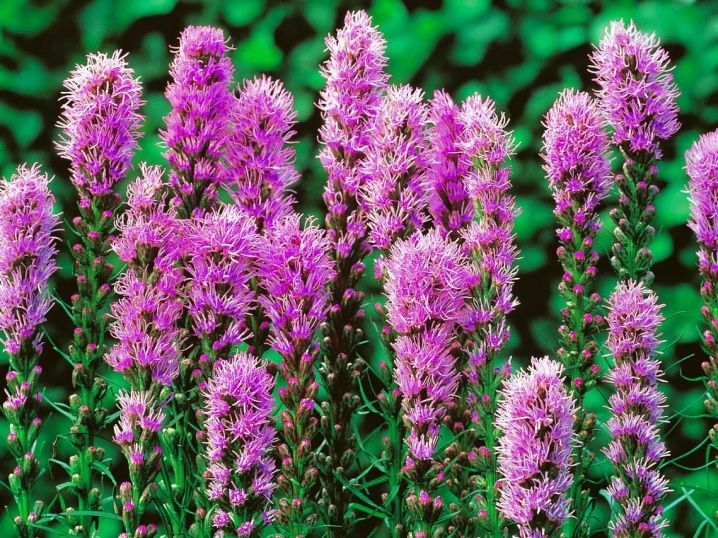
- Kobold. A beautiful variety, characterized by a delicate violet shade of inflorescences. The plant is undersized, reaching no more than 40 cm in height.
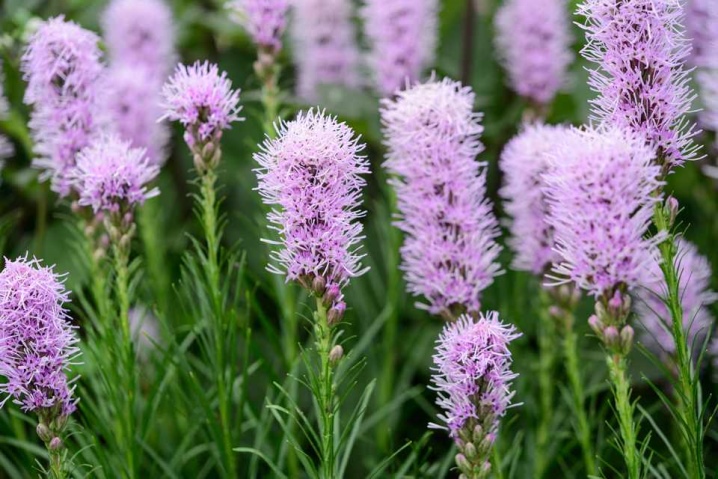
- Floristan Violett. A variety from a tall group, the stem is 80-120 cm long. The shade of the spike-shaped inflorescence is dark purple, saturated.

- Flamingo. One of the most popular varieties. Has a deep pink color. It grows up to 80 cm, tolerates adverse climatic conditions well.
All these varieties today are easy to find in the form of seeds and grow on their own in the country or in the garden.


Landing
Correct planting of spikelet liatris is not particularly difficult, but requires care and accurate calculation. Seed germination is low, about 50%, when sowing directly into open ground, you may not get the desired result. Sowing seedlings is performed in March, having prepared a container with a mixture of humus and fine sand. Planting material for disinfection is placed in a solution of potassium permanganate. After 8-10 hours, empty floating achenes are removed.
The remaining material can be placed on top of the prepared soil mixture, having previously well moistened it. A mulching layer of sawdust is laid on top, which reduces the evaporation of moisture. After 7 days, the first shoots will appear, and the container will need to be rearranged in a place with good lighting. By 21 days after planting, a pick is performed, the seedlings are placed in new containers.


You need to provide them with enough room to form roots.
Planting in open ground is shown for already matured plants. It is carried out in dry weather, having previously introduced humus into the ground and carefully dug it up. The soil is moistened, the seedlings are placed in the ground up to the most common leaves, the roots are covered. The first 2-3 days are watered abundantly.

Growing from tubers
Planting liatris spikelet in tubers is also not difficult. Planting material is harvested in the fall, and in the spring, when the earth warms up, they are returned to the flower beds. Suitable for planting bulbs up to 2 cm in diameter, dry, without traces of rot. Planting is carried out in a prepared soil substrate, loose, with a lot of humus. Holes are prepared in the ground, the bulbs are placed in them upside down, sprinkled with earth, watered.


Care
In order for liatris spikelet to grow and develop well in the open field, it needs to provide decent conditions. This plant is very sensitive to excess moisture, proximity to groundwater. It is imperative to ensure that spikelet liatris is planted in a dry, well-lit place where moisture stagnation is excluded.
Watering
Regular watering is still needed for the plant. In the warm season, it is carried out 2-3 times a week, depending on the intensity of moisture evaporation. If it rains, you can cancel the mandatory procedure.

Loosening and hilling
The roots of liatris spikelet are often exposed under the influence of external factors. This should not be allowed, as the plant may die. Loosening and hilling helps to save the situation. These agrotechnical procedures help keep the soil breathable and protect the roots. It is necessary to loosen and huddle the ground at least once a week, trying not to damage the plant.
Additionally, mulching can be used to maintain an optimal microclimate at the roots.
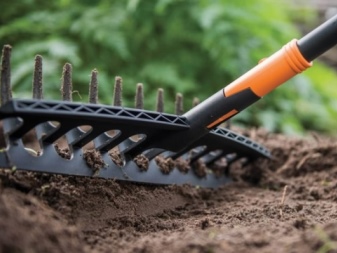

Fertilizer
When the time comes for flowering, the spicate liatrix has to pay maximum attention. In the spring, before the emergence of seedlings, fertilizing is applied to the soil on a nitrogen basis. Further, in the summer months, a remedy is used that combines potassium and phosphorus mineral complexes. To preserve the decorative effect, spikelet liatris must be regularly freed from dead inflorescences.


Wintering
For the subsequent spring planting, the tubers need to be dug out for the winter. To do this, wait until the foliage dries up, and carry out the separation of the planting material. The dug out bulbs are cleaned of clods of earth. Tubers with a diameter of over 20 mm are considered optimal for planting. They are dried, sent to storage in a place with a moderate air temperature.
Shelter for the winter is needed in regions where winters are snowless and frosty, as well as in the northern regions of the Russian Federation and in the middle lane. In this case, spikelet liatris is not dug up, covered with sacking in several layers, mulch or spruce branches. In the south, there is little need for additional security measures.

Reproduction methods
Spikelet liatris supports 3 main breeding methods: dividing the root, tubers and seeds... If there is at least 1 such flower in the garden, you can use its ability to sprout abundantly. After the formation of new root tubers, it is enough to separate them and plant them in the desired place. You can find such planting material in stores. The selected tuber is placed on a prepared area, buried 3-10 cm, with a distance between adjacent bulbs of at least 20 cm, watered and covered with mulch.

When sowing seeds, seedling and seedless cultivation of liatris spikelet is possible. Due to the unpretentiousness of the culture, usually complex and long preliminary preparation is not needed. Seeds are placed in open ground in autumn or spring, it is recommended to pre-soak the planting material in growth stimulants for 12 hours.
The site for planting is dug up, fertilized - enough 10 liters of humus per 1 m2. Sowing is carried out in grooves up to 1.5 cm deep. Liatris, when planted with seeds, gives flowers only for 2-3 years. The optimal time for sowing in open ground is late autumn or early spring. With the seedling method of growing, the transplant is carried out when the plant forms a tuber.


Diseases and pests
Spikelet liatris is naturally quite resistant to the development of various diseases. If the growing conditions are violated, waterlogging of the roots, the plant can be observed root rot rapidly attacking tubers... When it is detected, the rotten fate of the root is cut out, the plant is dug up, soaked in a fungicide. The landing site is drained, the soil moisture regime is changed.
Among pests, the greatest threat is garden snails, bears... There are many means to combat them. One of the best in the elimination of pests in the garden is considered a granular product "Thunderstorm". Against the bear they release "Medvetox" - a bait that is toxic to this predator. Sometimes hand-made traps are set.

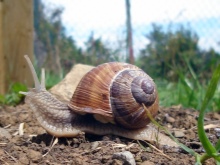
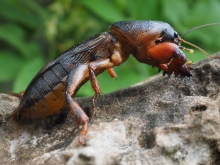
For the features of the care of the liatrix, see below.







































































































The comment was sent successfully.